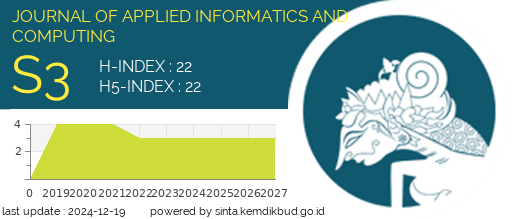Evaluation of Wireless LAN Quality of Service (QoS) in Primary Education Using TIPHON Standards
DOI:
https://doi.org/10.30871/jaic.v9i2.8979Keywords:
Quality of Service (QoS), Wireless LAN, TIPHON Standards, Educational NetworksAbstract
In the current digital era, internet connectivity in schools is crucial to support teaching and learning activities. SD Negeri 2 Sumber has implemented a wireless LAN network to provide internet access for students and teachers. This study aims to evaluate the network performance by measuring Quality of Service or QoS parameters, namely throughput, packet loss, delay, and jitter. The evaluation was conducted using Wireshark to monitor network traffic. The results show that the average throughput for video streaming is 4.251 Kbps, browsing is 1.425 Kbps, and downloading is 3.106 Kbps. The average packet loss is 1.66 % for video streaming, 4.6 % for browsing, and 2.66 % for downloading. The average delay for video streaming is 1.64 ms, browsing is 5.92 ms, and downloading is 2.32 ms. The average jitter is 1.62 ms for video streaming, 5.92 ms for browsing, and 2.16 ms for downloading. Based on the QoS parameters, the network quality is categorized as good according to TIPHON standards with a final score of 3.75. Although the overall network quality is good, there are several areas that need optimization, such as browsing activities, which show slightly higher throughput and jitter compared to other activities. This study provides a clear overview of wireless network performance and offers recommendations for further optimization to enhance user experience, particularly in activities involving browsing and school administration.
Downloads
References
[1] E. P. Saputra, A. Saryoko, M. Maulidah, N. Hidayati, and S. Dalis, “Analisis Quality of Service (QoS) Performa Jaringan Internet Wireless LAN PT. Bhineka Swadaya Pertama,” EVOLUSI J. Sains Dan Manaj., vol. 11, no. 1, Mar. 2023, doi: 10.31294/evolusi.v11i1.14955.
[2] Aprianto Budiman, M. Ficky Duskarnaen, and Hamidillah Ajie, “Analisis Quality Of Service (Qos) Pada Jaringan Internet Smk Negeri 7 Jakarta,” PINTER J. Pendidik. Tek. Inform. Dan Komput., vol. 4, no. 2, pp. 32–36, Dec. 2020, doi: 10.21009/pinter.4.2.6.
[3] A. R. Maulana, H. Walidainy, and M. Irhamsyah, “Analisis Quality of Service (QoS) Jaringan Internet Pada Website e-Learning Universitas Syiah Kuala Berbasis Wireshark”.
[4] M. Hasbi and N. R. Saputra, “Analisis Quality Of Service (Qos) Jaringan Internet Kantor Pusat King Bukopin Dengan Menggunakan Wireshark”.
[5] A. Yusuf and E. P. Rohmawan, “Analisa Quality Of Service Jaringan VSAT Menggunakan Wireshark”.
[6] D. A. Rachman, Y. Muhyidin, and M. A. Sunandar, “Analysis Quality Of Service Of Internet Network Fiber To The Home Service Pt. Xyz Using Wireshark,” J. Inform. Dan Tek. Elektro Terap., vol. 11, no. 3s1, Sep. 2023, doi: 10.23960/jitet.v11i3s1.3436.
[7] N. A. Damayanti, F. Imansyah, L. S. A. Putra, and J. Marpaung, “Analisis Quality Of Service Pada Jaringan Iconnet Menggunakan Aplikasi Wireshak”.
[8] P. R. Utami, “Analisis Perbandingan Quality Of Service Jaringan Internet Berbasis Wireless Pada Layanan Internet Service Provider (Isp) Indihome Dan First Media,” J. Ilm. Teknol. Dan Rekayasa, vol. 25, no. 2, pp. 125–137, 2020, doi: 10.35760/tr.2020.v25i2.2723.
[9] I. S. N. Nisa, Rahmat Miyarno Saputro, Tegar Fatwa Nugroho, and Alfirna Rizqi Lahitani, “Analisis Quality of Service (QoS) Menggunakan Standar Parameter Tiphon pada Jaringan Internet Berbasis Wi-Fi Kampus 1 Unjaya,” Teknomatika J. Inform. Dan Komput., vol. 17, no. 1, pp. 1–9, Apr. 2024, doi: 10.30989/teknomatika.v17i1.1307.
[10] H. Kurniawan, “Analisis QoS (Quality of Service) Jaringan Internet Kampus STMIK Pontianak,” 2022.
[11] R. M. N. Halim and S. Agung, “Analisis QoS Dan RMA Jaringan WISP Balai Bahasa Provinsi Sumatera Selatan,” J. Bina Komput., vol. 4, no. 2, pp. 1–6, Dec. 2022, doi: 10.33557/jbkom.v4i2.1997.
[12] A. A. Slameto and M. Khozinul Asror, “Analisis Perbandingan Kinerja Jaringan WLAN 2,4 Ghz Dan 5 Ghz Pada Proses Tethering Menggunakan Metode QOS,” J. Process., vol. 18, no. 2, Nov. 2023, doi: 10.33998/processor.2023.18.2.883.
[13] H. A. Saputra and G. M. Saputra, “Analisis QOS Jaringan 4G Dengan Menggunkan Aplikasi Wireshark (Studi Kasus : Tepian Samarinda, Taman Samarinda, dan Taman Cerdas),” vol. 5, no. 1, 2020.
[14] Valia Yoga Pudya Ardhana and M. D. Mulyodiputro, “Analisis Quality of Service (QoS) Jaringan Internet Universitas Menggunakan Metode Hierarchical Token Bucket (HTB),” J. Inform. Manag. Inf. Technol., vol. 3, no. 2, pp. 70–76, Apr. 2023, doi: 10.47065/jimat.v3i2.257.
[15] B. Pamungkas and F. A. Sutanto, “Penerapan Metode Quality of Service (QoS) dalam Analisis Kualitas Jaringan Internet Burjo Pantry Semarang,” J. JTIK J. Teknol. Inf. Dan Komun., vol. 8, no. 2, pp. 367–373, Apr. 2024, doi: 10.35870/jtik.v8i2.1932.
[16] A. Budiman, A. Sucipto, and A. R. Dian, “Analisis Quality of Service Routing MPLS OSPF Terhadap Gangguan Link Failure,” Techno.Com, vol. 20, no. 1, pp. 28–37, Feb. 2021, doi: 10.33633/tc.v20i1.4038.
[17] M. R. Kamil, F. Arzalega, and A. Sani, “Analisis Kualitas Layanan Jaringan Internet Wifi PT.XYZ dengan Metode QoS (Quality of Service),” vol. 1, no. 2, 2023.
Downloads
Published
How to Cite
Issue
Section
License
Copyright (c) 2025 Hizkiana Ruli Oktaseli, Andika Agus Slameto

This work is licensed under a Creative Commons Attribution-ShareAlike 4.0 International License.
Authors who publish with this journal agree to the following terms:
- Authors retain copyright and grant the journal right of first publication with the work simultaneously licensed under a Creative Commons Attribution License (Attribution-ShareAlike 4.0 International (CC BY-SA 4.0) ) that allows others to share the work with an acknowledgement of the work's authorship and initial publication in this journal.
- Authors are able to enter into separate, additional contractual arrangements for the non-exclusive distribution of the journal's published version of the work (e.g., post it to an institutional repository or publish it in a book), with an acknowledgement of its initial publication in this journal.
- Authors are permitted and encouraged to post their work online (e.g., in institutional repositories or on their website) prior to and during the submission process, as it can lead to productive exchanges, as well as earlier and greater citation of published work (See The Effect of Open Access).











